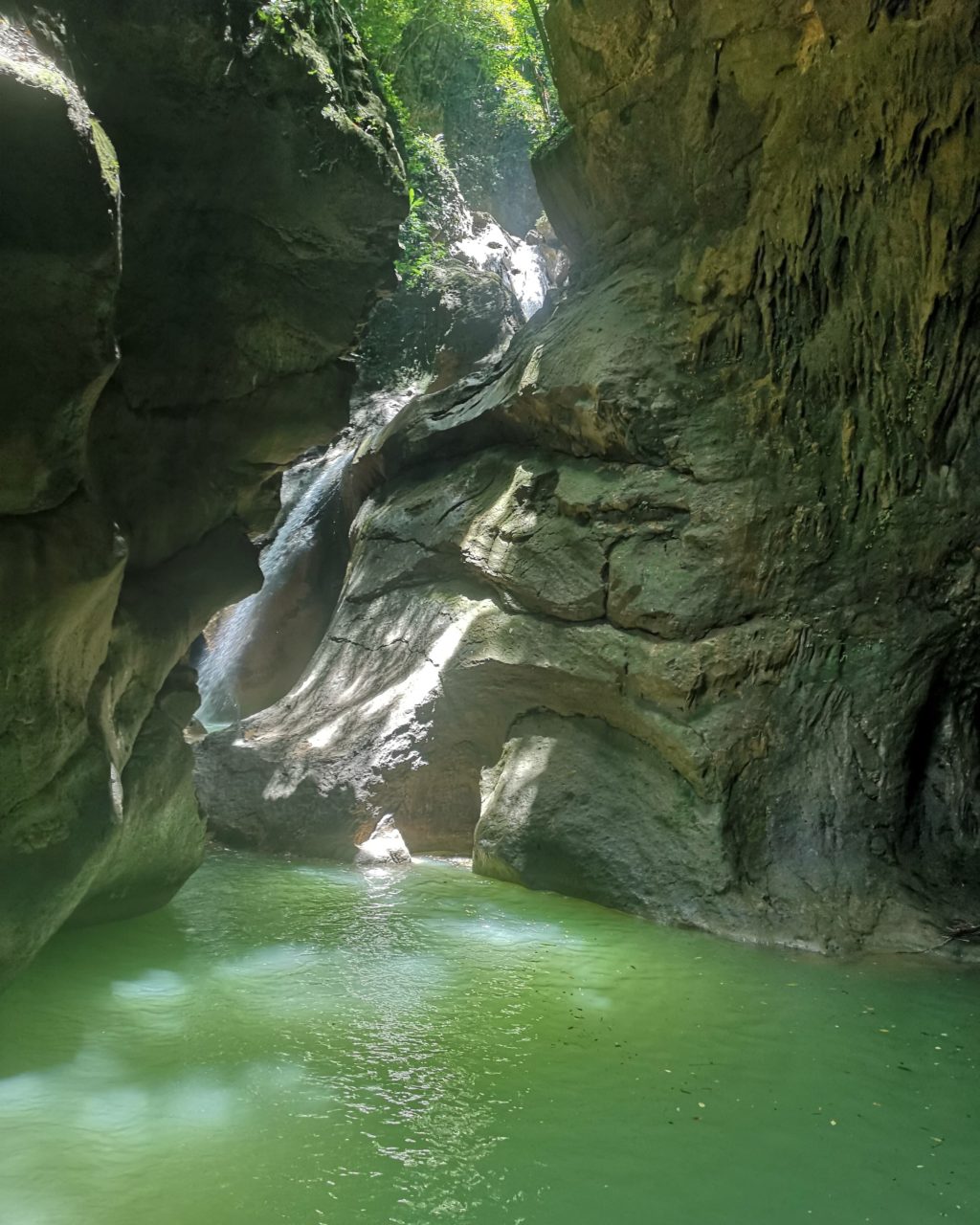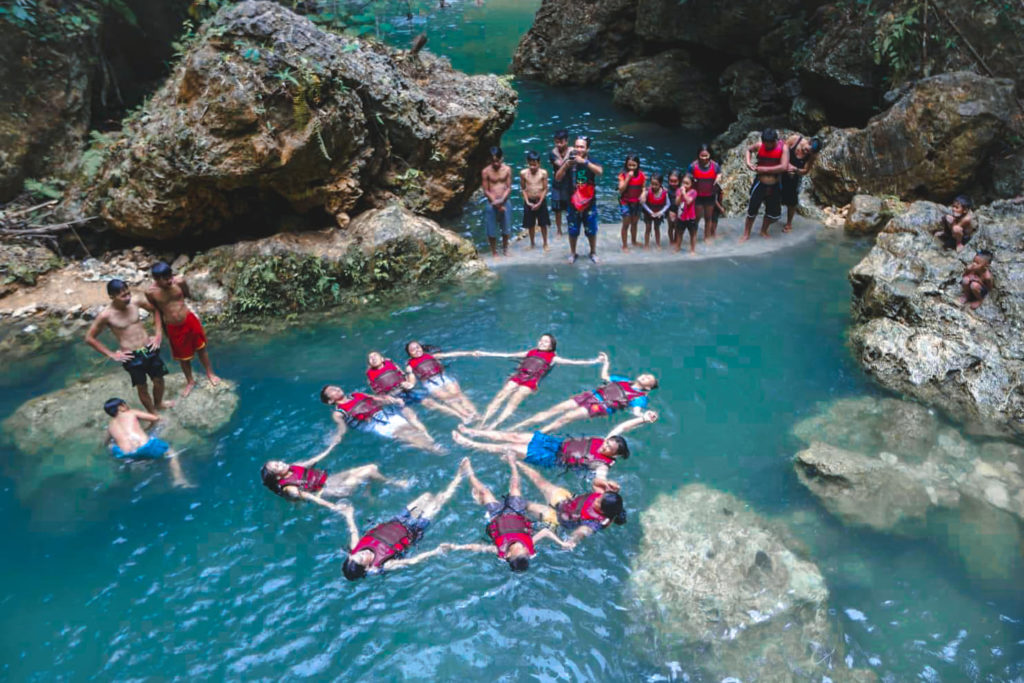
The “Malalag” found underneath the Dingayop waterfalls. /CDND photo
Cebu City, Philippines—Looking for a new destination this summer?
You might want to check out Dingayop Spring and Nature Park and the Eagle’s Cave in the beautiful valley of Barangay Obo, a mountain barangay of Dalaguete town.
The place is approximately 84 kilometers south of Cebu City.

Photo courtesy of Adelo Amancio
Dingayop Spring, White Rock
The cold spring is surrounded by a favorable environment as it is enclosed by a wide variety of trees that give it a cool temperature.
The spring is comprised of at least four different levels, which come from the “Malalag” found underneath the Dingayop waterfalls.
Warlito Santillan, one of the guides, explained that the “Malalag” was called as such because of its color, which means yellowish in Cebuano.
“Gitawag pud na siya’g “Malalag” tungod kay may pagkalalag ang iyang kolor tungod sa ka lawom sa tubig, (We called it “Malalag” because of its yellowish color that is due to its deepness),” Santillan told CDN Digital in an interview.
Photo courtesy of Adelo Amancio
Also, he said no one, even the guides themselves, has ever reach the spring’s bottom.
The first level is about eight feet deep, the second is four to six feet, the third one is about 15 feet while the topmost “Malalag” is about 20 feet deep.
Atop the spring lies the White Rock—a white coloured cliff that looks like a gigantic rock.
The White Rock /CDND photo
With an entrance fee of P50 per person and P20 for the trail guide, one can already experience the cold waters of the spring and take pictures at the scenic White rock.
Aside from being a new tourist hub, Dingayop spring also serves as the source of potable water of the town’s lower barangays and some adjacent barangays of Barangay Obo.
The spillage or the excess water from the tank adds up to the water supply, which goes directly to the first and second levels of the spring.
The Eagle’s Cave
Given its name, a lot of local and foreign tourists would ask if there is an actual eagle living inside the cave.
The answer is none.
But what’s inside the cave are unique formations of large stalactites and stalagmites.
Dalaguete’s Tourism Officer Victor Caruz said there are two stalagmite-filled rock formations lying beside each other that formed like that of an eagle’s legs.
The stalactites and stalagmites inside the Eagle’s Cave. /CDND photo
He said that seems to explain the origin of the name of the cave.
“There is a stalactite formation inside the cave that forms like an eagle’s two sturdy legs with a live python snake living beneath its legs. Makasulod ra ang mga turista near it, pero pag assess namo kauban ang mga personnel sa Department of Environment and Natural Resources (DENR) ug Department of Tourism (DoT), wala na ang phyton, migawas na punta sa forest park,” Caruz said in an interview through Facebook messenger.
(Tourists can go near it, and when we assessed it with the DENR and DoT, the python isn’t there anymore, it left for the forest park.)
But the natives and tour guides of Barangay Obo said the story seems to have lived long time ago when their ancestors first discovered the existence of the cave.
Tourists who wish to explore the cave must first register, wear a helmet with flashlight and hire a DOT-trained cave guide.
The entrance fee is P30 and the tour guide fee is P300 per person.
Booming tourism, jobs
Santillan said about 300 local tourists have already visited the spring since it was officially opened to the public last week, April 7, 2019.
“Bag-o pa lang ni siyang nailhan sa mga turista apan dugay na kaayo ni diri, panahon pa sa among mga katigulangan. Karon lang ni nahatagan og pagtagad, pag-atiman sa barangay, aron makatabang sab sa turismo sa Dalaguete,” Santillan said.
Photo courtesy of Adelo Amancio
“This is still new to tourists but this has been here for a long time already, even during the time of our ancestors. It is just now that it is given attention and care from the barangay so that it could help with the tourism of Dalaguete.)
Santillan said that aside from the increasing tourism industry in Dalaguete, these attractions also help them earn for living.
A single father of four, Santillan said the job helps him sustain the needs of his children aside from the money he earns from farming.
“Dako kaayo ni og gikatabang sa among panginabuhian. Gawas nga makatabang ni sa turismo sa Dalaguete, nakatabang pud ni og dako sa mga taga dinhi,” he said.
(This is a big help for our livelihood. Aside from helping the tourism of Dalaguete, it also helps the people here.)
At least ten DOT-trained guides are employed to take care of the place and the tourists. /bmjo

